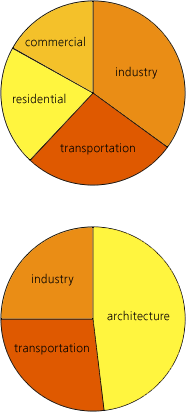9 November 2003
It’s the Architecture, Stupid!
From Turning Down the Global Thermostat by Christopher Hawthorne in the October 2003 issue of Metropolis:
“Traditionally assessments of U.S. energy consumption have been broken down into four categories: industry, which consumes about 35 percent of the total each year; transportation, 27 percent; residential, 21 percent; and commercial, 17 percent. Significantly energy consumption usually tracks pretty closely with carbon dioxide production because most of the energy consumed is in the form of fossil fuels, which release greenhouse gases — primarily carbon dioxide, methane, and nitrous oxide. Thus a pie chart showing carbon dioxide divides along roughly the same ratios as one showing energy use. ‘In every study it’s always broken down the same way,’ [Edward] Mazria says, ‘so when you look at it and ask who the bad guy is — it’s industry.’
 Mazria’s eureka moment came when he decided to redraw that pie chart with a separate slice just for architecture. He did this by combining the residential and commercial sectors, and then adding the portion of the industry sector that goes to the operation of industrial buildings and their construction. To get this last group of numbers Mazria used estimates of the so-called ‘embodied energy’ of industrial buildings. A key statistic for anybody hoping to build in a sustainable way, embodied energy is a measure of the total energy required to produce a particular material or building component and get it to a building site.
Mazria’s eureka moment came when he decided to redraw that pie chart with a separate slice just for architecture. He did this by combining the residential and commercial sectors, and then adding the portion of the industry sector that goes to the operation of industrial buildings and their construction. To get this last group of numbers Mazria used estimates of the so-called ‘embodied energy’ of industrial buildings. A key statistic for anybody hoping to build in a sustainable way, embodied energy is a measure of the total energy required to produce a particular material or building component and get it to a building site.
Mazria’s new math brought the architectural sector to a whopping 48 percent of total U.S. energy consumption. A similar rearranging of the chart for carbon dioxide production left architecture with 46 percent of the total. ‘I rounded the numbers down,’ he says. ‘I want to be careful about my numbers because people are going to attack them.’
What all of this means for Mazria is that the environmental movement has been scapegoating the wrong targets. ‘Look at SUVs,’ he says. ‘All the cars and trucks on the road account for about 6.5 percent of energy consumption in this country. If you figure SUVs as half of that, that’s 3, maybe 3.5 percent. So even if you doubled the gas mileage of every single SUV on the road, you’re talking about a marginal impact in a marginal area, all things considered. That kind of misguided focus actually keeps us from addressing the real issue.’ In other words, we’re worrying about cars when we should be worrying about buildings....
But is it fair to make architects responsible for the damage caused by the entire building industry? Mazria thinks so. He cites figures suggesting that architects design 77 percent of all nonresidential buildings, along with 70 percent of all multifamily and 25 percent of all single-family construction. And he argues that the percentage of architect-designed buildings is in fact higher than that because, as he writes, those figures ‘do not account for owner-supplied plans that were originally from architecture firms, designs by staff architects employed by building owners and developers, and single-family houses designed (but not stamped) by architects and interns.’
In Mazria’s mind, then, the architect is a perfectly legitimate new poster child for global warming: the leading part of the problem as well as, potentially, the solution. ‘Architects — and the government tends to forget this — specify every single material that goes into a building, from faucets to paint to carpet to wall materials to finishes to windows to roofing,’ he says. ‘Architects have the ability to change entire industries with the stroke of a pen. If we specify a material with low carbon dioxide emissions in its fabrication — say, floor tile, carpet, gypsum board — industry will respond. This is the American way. Architects are consumers; they’re not always aware of the incredible power they have to change the way products are manufactured.’...
He writes in his white paper: ‘We already know that buildings can be designed today to operate with less than half the energy of the average U.S. building at no additional cost. The design information needed to accomplish this is freely available.’...
The approach has also led the architect to criticize more quantitative and regulatory green initiatives, including the U.S. Green Building Council’s LEED certification program, which is currently the most expansive one in use in this country. ‘LEED-type programs can actually be damaging,’ Mazria says, ‘because they shift decisions about sustainability out of the realm of design at the workplace and put it in a separate, purely technical category. So every firm needs to get one person LEED certified, and they usually send the technical guy, not a design guy. And then that technical guy becomes the guy who has to get your design in shape for LEED, and that process becomes divorced from design.’”
See Edward Mazria’s original article from Solar Today (1MB PDF).
![]() 9 November 2003, 5:58 AM | LINK | Filed in
built, energy, sustainability
9 November 2003, 5:58 AM | LINK | Filed in
built, energy, sustainability
Read more items related by tag:

